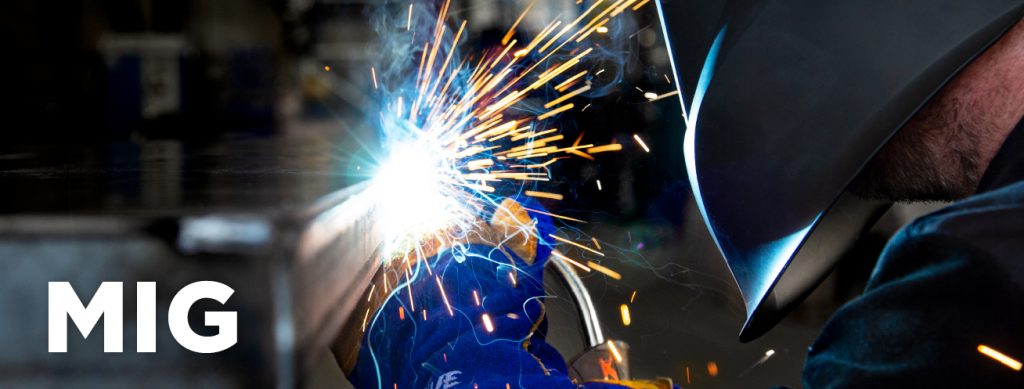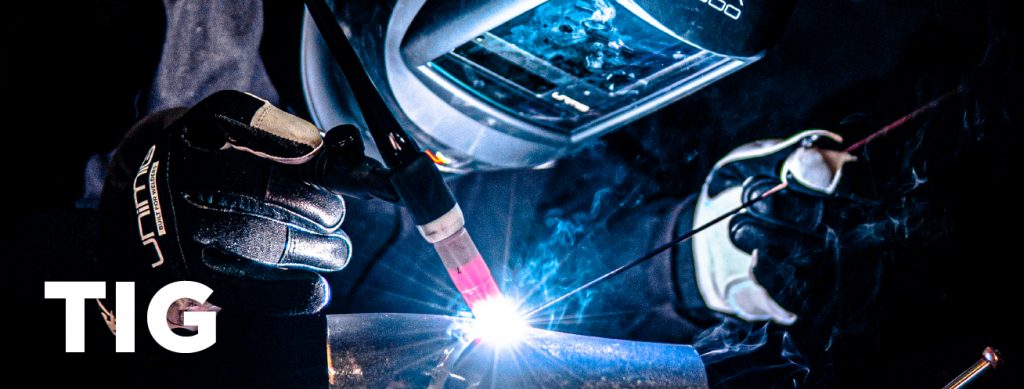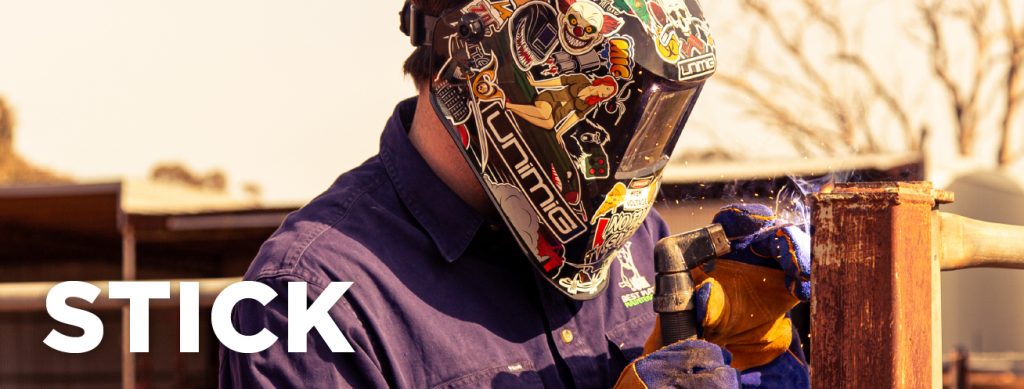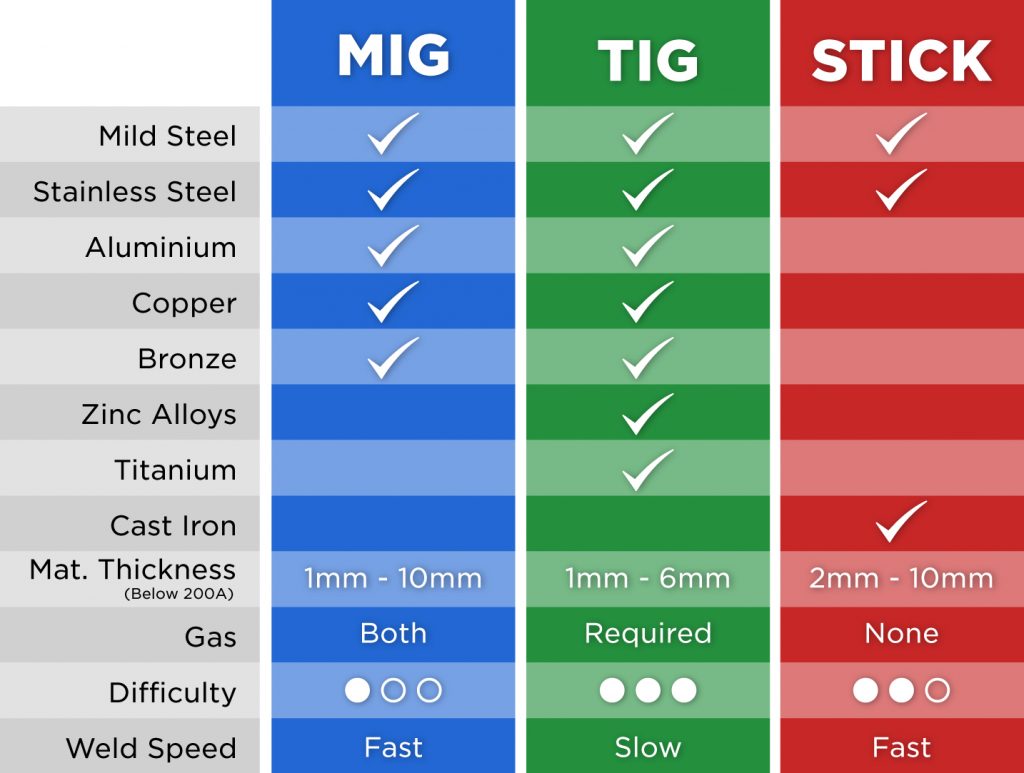MIG vs TIG vs Stick Welding
November 16, 2021
When it comes to welding, it’s not as simple as grabbing the first machine from the shelf, and off you go. There are a number of different welding types and processes, the main four being MIG, TIG and stick welding. Each one has its pros, cons and requires its own set of equipment and accessories.
So, which one is going to work best for what you’ve got planned?

Metal Inert Gas (MIG) Welding
Metal Inert Gas (MIG) welding is a welding process in which an electric arc is created between the workpiece and a solid wire. The wire (filler metal) is continuously fed through the welding machine and into the weld pool to form the weld.
The process of MIG welding is semi-automatic, as the machine does all the wire feeding for you, which is why MIG welding is considered one of the easiest types of welding to learn.
MIG welding is done with a MIG torch for mild and stainless steel and a spool gun for aluminium. A wire spool is attached inside the machine and fed through rollers into the torch liner and then out of the torch automatically, so once it’s set up, all you need to worry about is the settings.
There are only two settings on a MIG machine: voltage and wire feed speed. It’s relatively straightforward to set up, and because it’s as easy as aiming the gun in the weld joint and pulling the trigger, it’s the fastest way to weld.
The main downside to MIG welding is that it’s not very good in outside or windy conditions, as it’s a gas-shielded method. However, there’s good news. You can MIG weld with gasless wire as well.
MIG welding is used for a lot of fabrication work as it works on thin and thick materials, so it’s very versatile. Some common applications are things like frames, trailers, car panels and general fabrication. It is also commonly used for DIY and hobby projects because it is so easy to learn.
Flux-Cored Arc Welding (FCAW)
Flux-cored arc welding (FCAW) or gasless MIG, is set up and done almost exactly the same way as gas MIG, though there are a few differences.
Rather than a solid wire, a hollow wire that contains flux, which produces a protective layer of slag on the finished weld. The slag layer means that a shielding gas isn’t needed for flux-cored welding. You can also get gas-shielded flux-cored wire, but that’s generally only used for certain heavy-duty welds.
One of the main downsides to choosing flux-cored is that it can’t weld quite as thin material as standard MIG, and it’s not recommended for sheet metal or car panels.
FCAW welding is almost exclusively used on outdoor applications, as it eliminates problems like wind blowing away shielding gas. It’s also more forgiving on dirty or rusty surfaces, so any repairs or fabrication, like fences and gates, are some of the more popular uses of gasless MIG.
Check out our Gas vs Gasless post for more on the differences between gas MIG and gasless MIG.

Tungsten Inert Gas (TIG) Welding
Tungsten Inert Gas (TIG) welding is the process in which an arc is formed between a tungsten electrode and the workpiece to join the metals together. A filler rod is often fed into the weld pool to create a weld. Shielding gas is required to protect the weld from atmospheric contaminants.
TIG welding is considered the most challenging type of welding to learn because of all the variables involved and the coordination needed to feed the filler into the weld.
On top of learning how to make a proper weld, TIG welding is also more complicated because of the number of settings that can be adjusted. Plus, the more features the machine has the more settings that can be changed.
For example, the VIPER 180 AC/DC Mk II TIG Welder only has the standard set of pyramid settings (pre and post gas, up and down slope, peak amps, etc.).
In comparison, the RAZOR 320 AC/DC TIG/Stick Welder has some added features, like being able to change the AC waveforms as well as being capable of mixed arc welding. These features come with their own settings on top of all the normal ones the machine comes with.
TIG welding uses a non-consumable tungsten electrode, of which there are several different types, all with their pros and cons, which allows TIG welding to be the most versatile when it comes to metal types.
Once you’ve gotten the hang of TIG, you can also introduce a foot pedal to adjust the amps manually while you weld, rather than being limited to whatever you’ve set on the machine.
Despite how complicated it is and how long it takes to master, TIG is popular because of how much you can do with it. It works the best on thin sheet metals and aluminium, so it’s a great choice for most automotive work.
It’s not often used for production work, however, as it is quite a slow process. It’s also the most aesthetically pleasing, with its stacked dimes look, so it’s used on welds that will be seen or for artworks.

Manual Metal Arc (MMA) Welding
Manual Metal Arc (MMA) welding or ‘stick welding’ is the process in which a power source is used to create an electric arc between a flux covered electrode and the workpiece. To ignite an arc the electrode is struck against the metal and then melted into the joint to create the weld.
The flux covering acts as a protective layer for your weld, so no protective gas is needed. The protective coating on the electrode leaves behind a topcoat on your weld known as ‘slag’, which needs to be removed to expose a clean weld.
In some ways, stick welding is the easiest to set up, as there’s not much to it. All you need is an electrode, an electrode holder, and to set the amps on the machine.
On the other hand, it can take some practice to strike an arc in one go (and some electrodes are harder than others to start), and adjusting to the electrode melting away can be difficult. You have to move with the electrode, otherwise, your arc will get too long, and it’ll go out, or you could stick it to the workpiece instead.
Thanks to its simplicity, almost every welding machine can also stick weld, but you can get machines that are dedicated stick welders, which are super easy to work because their only setting is an amperage knob.
Stick welding is most commonly used for construction and on structural builds, as they’re the most capable when it comes to thick material. They’re also the most portable welding machine, so they’re great for on-site work.
The downsides to stick welding are that you can’t weld on very thin material, it can’t weld aluminium, and there’s usually more cleanup to do at the end of a weld.
